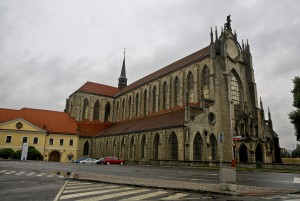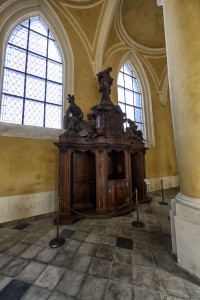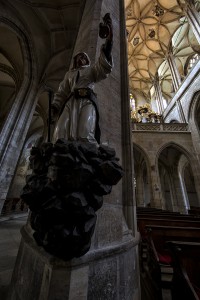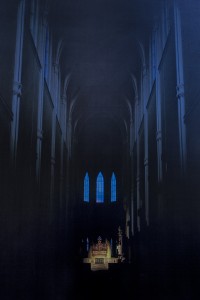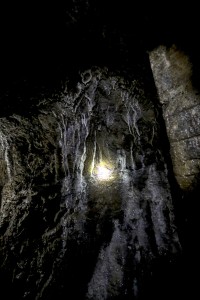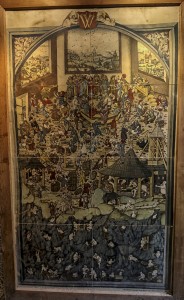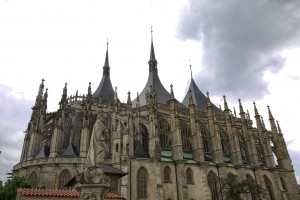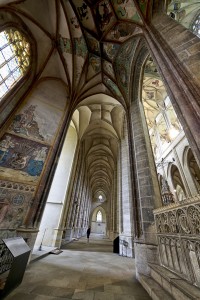It is believed that Kutna Hora was founded when the first Bohemian Cistercian monastery was established here in 1142. This monastery was founded by a nobleman Miroslav of Markvatice who donated the property to a group of monks from Waldsassen Germany. The Devil’s Bible was pawned to the this Monastery of Sedlec till the year 1290 and was housed either at this Cistercian Monastery or the Sedlec Ossuary which was part of this monastery complex located some 200 metres away.
This monastery was burnt down in 1421 by the Hussites. The old monastery church which fell to ruin was rebuilt around the year 1700 and stands today as the Church of the Assumption of Our Lady and Saint John the Baptist. In the Devil’s Prayer, this is the church where Denise confesses to Fr Zachery “I am the hand maiden of the Devil. I am here to unbirth what I have done”.
The Church of of the Assumption of Our Lady and Saint John the Baptist.
The confessional at Our Lady of Sedlec
Statue of the silver miner – Our Lady of Sedlec
On the summer solstice each year the altar of Our Lady of Sedlec perfectly lit by sunlight. This is a photograph taken of the image in the Cathedral.
Kutna Hora would soon become one of the richest towns in all of Europe with the discovery of silver. Indeed the Osel Mine would become the largest silver mine in the world. The origin of the mine is unknown but the most common legend tells a story of a monk named Anthony from the monastery in Sedlec. According to this legend the monk found out three silver rods and so began the mine on the property of the monastery. The Cistercian monastery gained extraordinary profits as the silver ore was dug out from under it’s lands.
Thanks to silver mines, Kutná Hora gained excessive wealth and became the second most important city in the Kingdom of Bohemia, after Prague. Indeed the Prague groschen was minted in Kutna Hora from 1300 to 1547.
A tunnel in the Osel Mine
Medieval Mosaic showing the life of Kutna Hora and the Osel Mine
The tunnels of the Osel mine descend almost six hundred metres into the depths of the earth, dug out entirely by hand over a period of five hundred years. During the Hussite wars of the fifteenth century, some two thousand Hussites killed by the crusaders of Pope Martin V were thrown down the mine shafts, their bodies left to rot. In 1546, the mine was completely flooded and in time with the thirty year war, plagues and other disasters the mine never fully recovered. In the fire of 1770, the town of Kutna Hora was devastated by a fire and the detailed plans of the location of the tunnels and the shafts were lost forever.
Perfect black shot at ISO25600 at f2.8 inside the Osel Mine with the lights shut off. It was where light had come to die.
In the Devil’s Prayer, Jakub takes Denise Russo to the Santa Barbara Church. On the roof of the Cathedral, he shows her the carving of the Devil near the small door which leads to the spiral staircase into the Devil’s Library located in the lost shaft’s of the Osel Mine.
The Santa Barbara Church is built in the style of a Cathedral. St Barbara is the patron saint of miners as can be expected from a town which was almost wholly built from the profits of the largest silver mine in the world. Construction on the church began in 1388.
The original design was for a much larger church, perhaps twice the size of the present building. Construction, however, depended on the prosperity of the town’s silver mines, which progressively became much less productive.
Its architecture with glass windows, multiple altars and choir stalls is complemented with medieval frescoes depicting mining life.
Front view of the Santa Barbara Church, Kutna Hora
Side view of the Santa Barbara Church
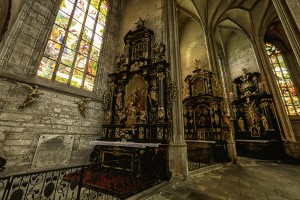
Inside the Santa Barbara Church – Kutna Hora
The carving of the Devil on the roof of the Church
God and the Devil are intertwined for one does not exist without the other.
